Accounting Theory and Current Issues Tutorial Question Assignment
VerifiedAdded on 2023/01/11
|11
|1935
|20
Homework Assignment
AI Summary
This assignment provides a comprehensive analysis of accounting theory and current issues, addressing key topics through tutorial questions. It begins by examining relevance and faithful representation in financial reporting, providing examples where information is relevant but not faithfully represented, not relevant but faithfully represented, and relevant and faithfully represented. The assignment then delves into the social contract and its relationship with legitimacy, exploring how companies use disclosure policies. Further, the assignment covers depreciation calculations, goodwill impairment entries, and lease accounting, including implicit interest rate calculations and journal entries for both the lessee and lessor. The document includes worked examples and journal entries for each concept, providing a thorough understanding of the topics covered.

Accounting Theory & Current Issues Tutorial Question Assignment
Paraphrase This Document
Need a fresh take? Get an instant paraphrase of this document with our AI Paraphraser
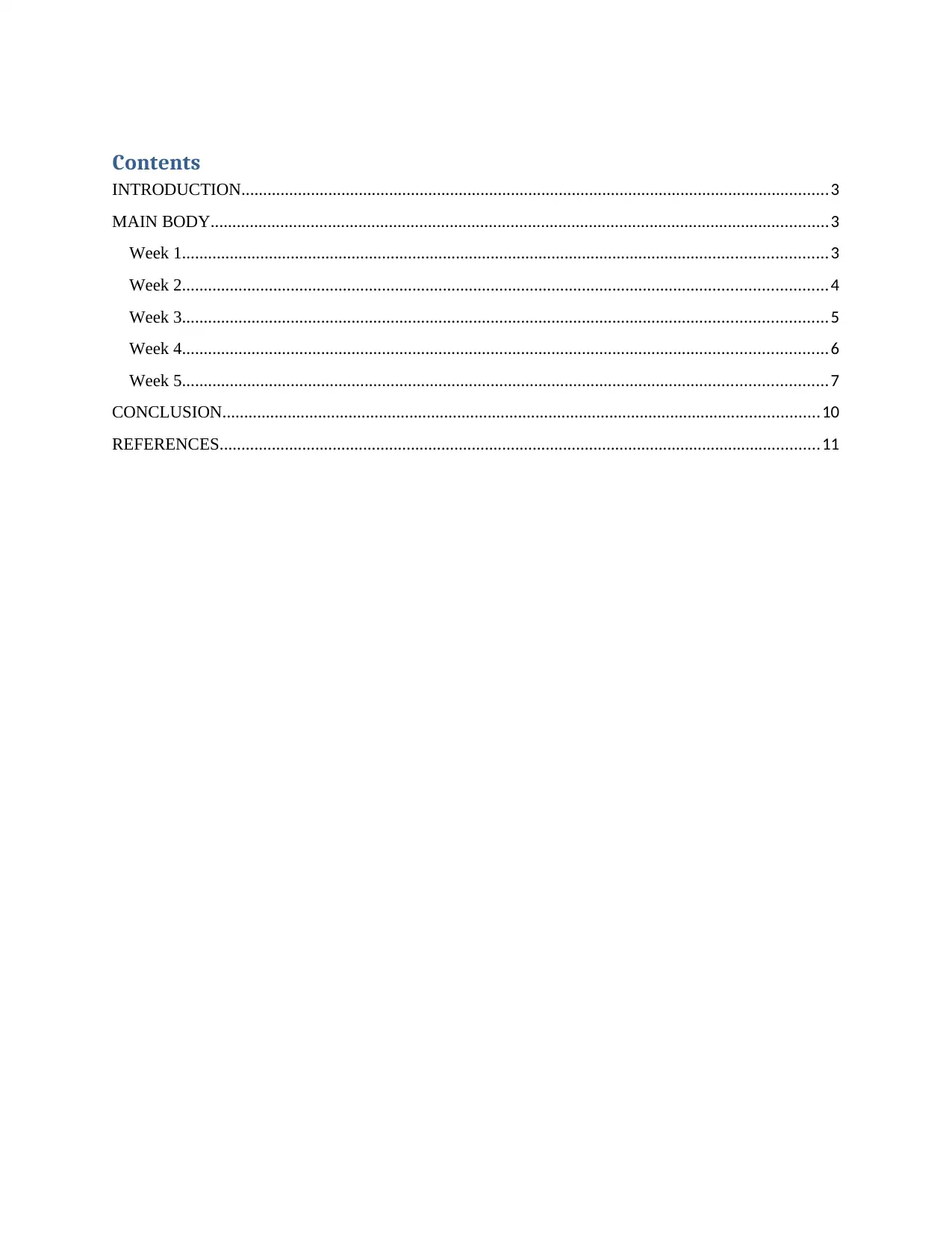
Contents
INTRODUCTION.......................................................................................................................................3
MAIN BODY..............................................................................................................................................3
Week 1....................................................................................................................................................3
Week 2....................................................................................................................................................4
Week 3....................................................................................................................................................5
Week 4....................................................................................................................................................6
Week 5....................................................................................................................................................7
CONCLUSION.........................................................................................................................................10
REFERENCES..........................................................................................................................................11
INTRODUCTION.......................................................................................................................................3
MAIN BODY..............................................................................................................................................3
Week 1....................................................................................................................................................3
Week 2....................................................................................................................................................4
Week 3....................................................................................................................................................5
Week 4....................................................................................................................................................6
Week 5....................................................................................................................................................7
CONCLUSION.........................................................................................................................................10
REFERENCES..........................................................................................................................................11
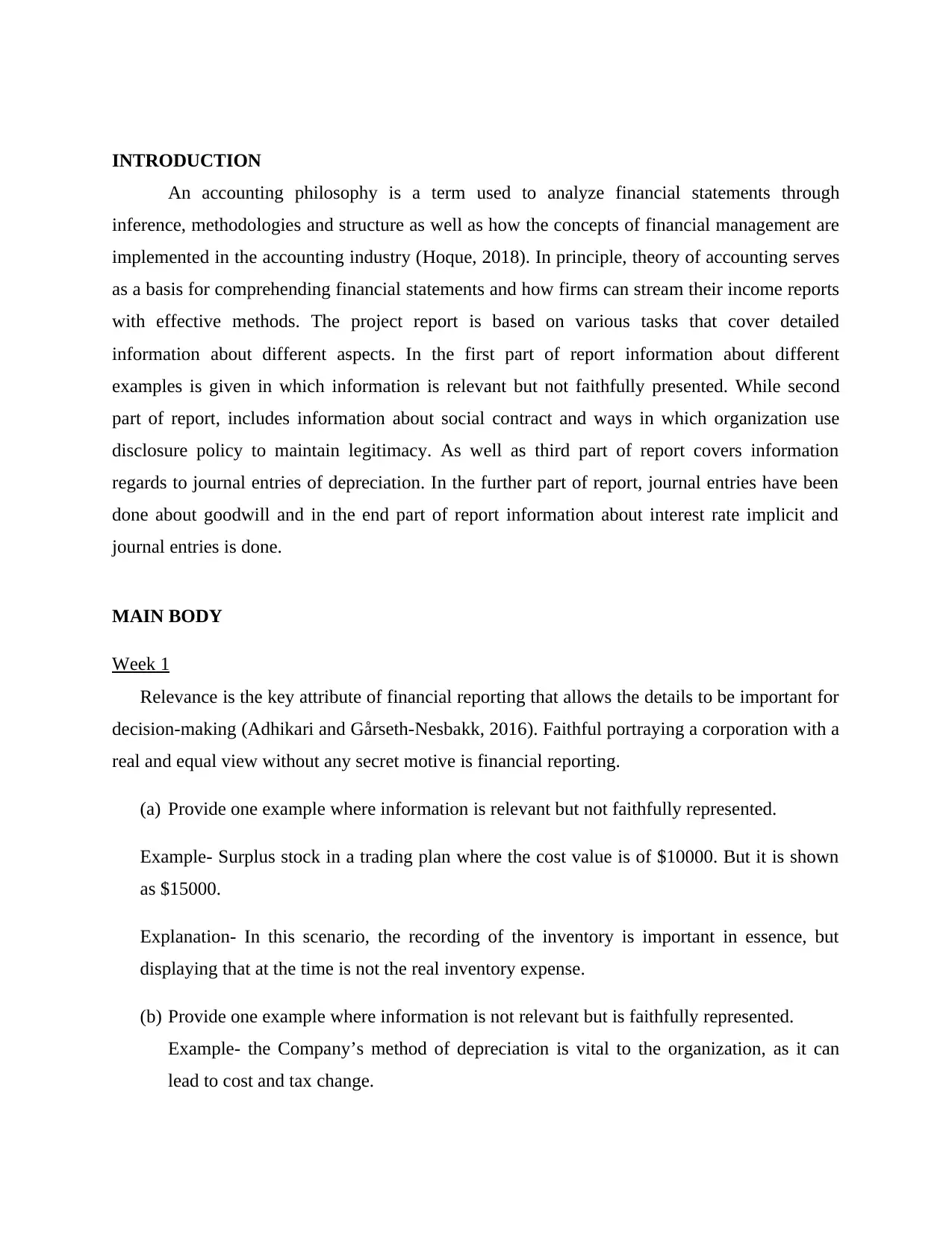
INTRODUCTION
An accounting philosophy is a term used to analyze financial statements through
inference, methodologies and structure as well as how the concepts of financial management are
implemented in the accounting industry (Hoque, 2018). In principle, theory of accounting serves
as a basis for comprehending financial statements and how firms can stream their income reports
with effective methods. The project report is based on various tasks that cover detailed
information about different aspects. In the first part of report information about different
examples is given in which information is relevant but not faithfully presented. While second
part of report, includes information about social contract and ways in which organization use
disclosure policy to maintain legitimacy. As well as third part of report covers information
regards to journal entries of depreciation. In the further part of report, journal entries have been
done about goodwill and in the end part of report information about interest rate implicit and
journal entries is done.
MAIN BODY
Week 1
Relevance is the key attribute of financial reporting that allows the details to be important for
decision-making (Adhikari and Gårseth-Nesbakk, 2016). Faithful portraying a corporation with a
real and equal view without any secret motive is financial reporting.
(a) Provide one example where information is relevant but not faithfully represented.
Example- Surplus stock in a trading plan where the cost value is of $10000. But it is shown
as $15000.
Explanation- In this scenario, the recording of the inventory is important in essence, but
displaying that at the time is not the real inventory expense.
(b) Provide one example where information is not relevant but is faithfully represented.
Example- the Company’s method of depreciation is vital to the organization, as it can
lead to cost and tax change.
An accounting philosophy is a term used to analyze financial statements through
inference, methodologies and structure as well as how the concepts of financial management are
implemented in the accounting industry (Hoque, 2018). In principle, theory of accounting serves
as a basis for comprehending financial statements and how firms can stream their income reports
with effective methods. The project report is based on various tasks that cover detailed
information about different aspects. In the first part of report information about different
examples is given in which information is relevant but not faithfully presented. While second
part of report, includes information about social contract and ways in which organization use
disclosure policy to maintain legitimacy. As well as third part of report covers information
regards to journal entries of depreciation. In the further part of report, journal entries have been
done about goodwill and in the end part of report information about interest rate implicit and
journal entries is done.
MAIN BODY
Week 1
Relevance is the key attribute of financial reporting that allows the details to be important for
decision-making (Adhikari and Gårseth-Nesbakk, 2016). Faithful portraying a corporation with a
real and equal view without any secret motive is financial reporting.
(a) Provide one example where information is relevant but not faithfully represented.
Example- Surplus stock in a trading plan where the cost value is of $10000. But it is shown
as $15000.
Explanation- In this scenario, the recording of the inventory is important in essence, but
displaying that at the time is not the real inventory expense.
(b) Provide one example where information is not relevant but is faithfully represented.
Example- the Company’s method of depreciation is vital to the organization, as it can
lead to cost and tax change.
⊘ This is a preview!⊘
Do you want full access?
Subscribe today to unlock all pages.

Trusted by 1+ million students worldwide
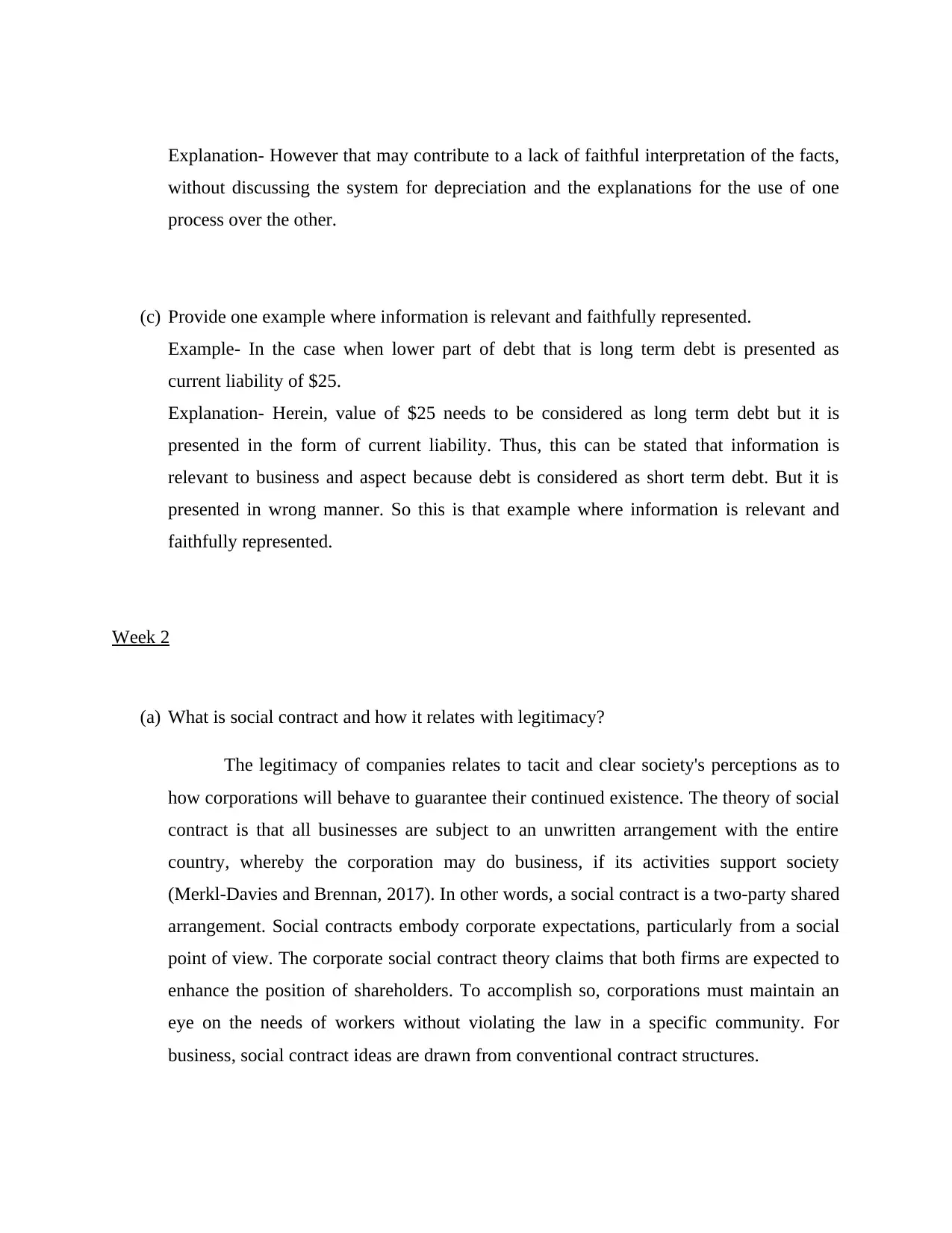
Explanation- However that may contribute to a lack of faithful interpretation of the facts,
without discussing the system for depreciation and the explanations for the use of one
process over the other.
(c) Provide one example where information is relevant and faithfully represented.
Example- In the case when lower part of debt that is long term debt is presented as
current liability of $25.
Explanation- Herein, value of $25 needs to be considered as long term debt but it is
presented in the form of current liability. Thus, this can be stated that information is
relevant to business and aspect because debt is considered as short term debt. But it is
presented in wrong manner. So this is that example where information is relevant and
faithfully represented.
Week 2
(a) What is social contract and how it relates with legitimacy?
The legitimacy of companies relates to tacit and clear society's perceptions as to
how corporations will behave to guarantee their continued existence. The theory of social
contract is that all businesses are subject to an unwritten arrangement with the entire
country, whereby the corporation may do business, if its activities support society
(Merkl-Davies and Brennan, 2017). In other words, a social contract is a two-party shared
arrangement. Social contracts embody corporate expectations, particularly from a social
point of view. The corporate social contract theory claims that both firms are expected to
enhance the position of shareholders. To accomplish so, corporations must maintain an
eye on the needs of workers without violating the law in a specific community. For
business, social contract ideas are drawn from conventional contract structures.
without discussing the system for depreciation and the explanations for the use of one
process over the other.
(c) Provide one example where information is relevant and faithfully represented.
Example- In the case when lower part of debt that is long term debt is presented as
current liability of $25.
Explanation- Herein, value of $25 needs to be considered as long term debt but it is
presented in the form of current liability. Thus, this can be stated that information is
relevant to business and aspect because debt is considered as short term debt. But it is
presented in wrong manner. So this is that example where information is relevant and
faithfully represented.
Week 2
(a) What is social contract and how it relates with legitimacy?
The legitimacy of companies relates to tacit and clear society's perceptions as to
how corporations will behave to guarantee their continued existence. The theory of social
contract is that all businesses are subject to an unwritten arrangement with the entire
country, whereby the corporation may do business, if its activities support society
(Merkl-Davies and Brennan, 2017). In other words, a social contract is a two-party shared
arrangement. Social contracts embody corporate expectations, particularly from a social
point of view. The corporate social contract theory claims that both firms are expected to
enhance the position of shareholders. To accomplish so, corporations must maintain an
eye on the needs of workers without violating the law in a specific community. For
business, social contract ideas are drawn from conventional contract structures.
Paraphrase This Document
Need a fresh take? Get an instant paraphrase of this document with our AI Paraphraser
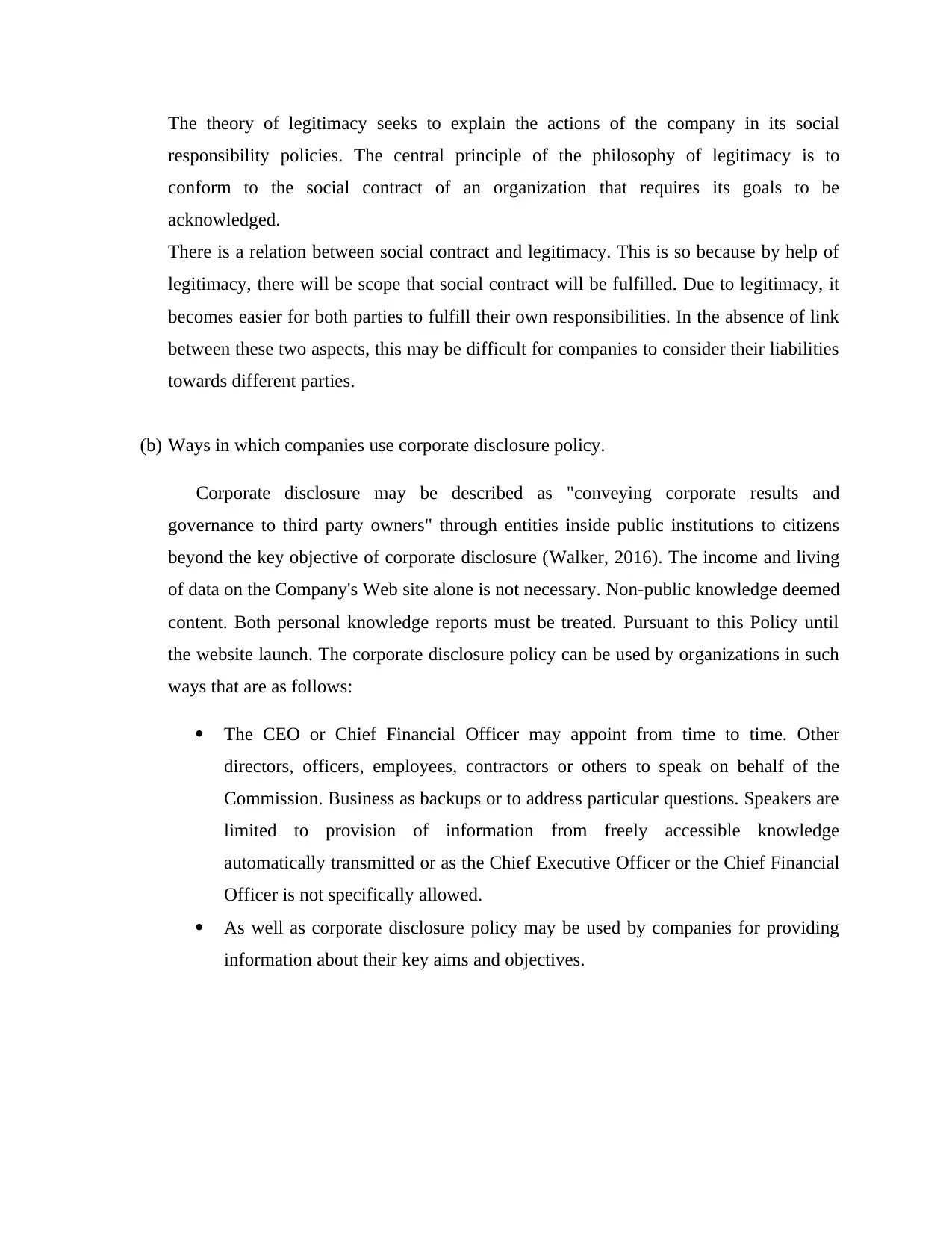
The theory of legitimacy seeks to explain the actions of the company in its social
responsibility policies. The central principle of the philosophy of legitimacy is to
conform to the social contract of an organization that requires its goals to be
acknowledged.
There is a relation between social contract and legitimacy. This is so because by help of
legitimacy, there will be scope that social contract will be fulfilled. Due to legitimacy, it
becomes easier for both parties to fulfill their own responsibilities. In the absence of link
between these two aspects, this may be difficult for companies to consider their liabilities
towards different parties.
(b) Ways in which companies use corporate disclosure policy.
Corporate disclosure may be described as "conveying corporate results and
governance to third party owners" through entities inside public institutions to citizens
beyond the key objective of corporate disclosure (Walker, 2016). The income and living
of data on the Company's Web site alone is not necessary. Non-public knowledge deemed
content. Both personal knowledge reports must be treated. Pursuant to this Policy until
the website launch. The corporate disclosure policy can be used by organizations in such
ways that are as follows:
The CEO or Chief Financial Officer may appoint from time to time. Other
directors, officers, employees, contractors or others to speak on behalf of the
Commission. Business as backups or to address particular questions. Speakers are
limited to provision of information from freely accessible knowledge
automatically transmitted or as the Chief Executive Officer or the Chief Financial
Officer is not specifically allowed.
As well as corporate disclosure policy may be used by companies for providing
information about their key aims and objectives.
responsibility policies. The central principle of the philosophy of legitimacy is to
conform to the social contract of an organization that requires its goals to be
acknowledged.
There is a relation between social contract and legitimacy. This is so because by help of
legitimacy, there will be scope that social contract will be fulfilled. Due to legitimacy, it
becomes easier for both parties to fulfill their own responsibilities. In the absence of link
between these two aspects, this may be difficult for companies to consider their liabilities
towards different parties.
(b) Ways in which companies use corporate disclosure policy.
Corporate disclosure may be described as "conveying corporate results and
governance to third party owners" through entities inside public institutions to citizens
beyond the key objective of corporate disclosure (Walker, 2016). The income and living
of data on the Company's Web site alone is not necessary. Non-public knowledge deemed
content. Both personal knowledge reports must be treated. Pursuant to this Policy until
the website launch. The corporate disclosure policy can be used by organizations in such
ways that are as follows:
The CEO or Chief Financial Officer may appoint from time to time. Other
directors, officers, employees, contractors or others to speak on behalf of the
Commission. Business as backups or to address particular questions. Speakers are
limited to provision of information from freely accessible knowledge
automatically transmitted or as the Chief Executive Officer or the Chief Financial
Officer is not specifically allowed.
As well as corporate disclosure policy may be used by companies for providing
information about their key aims and objectives.
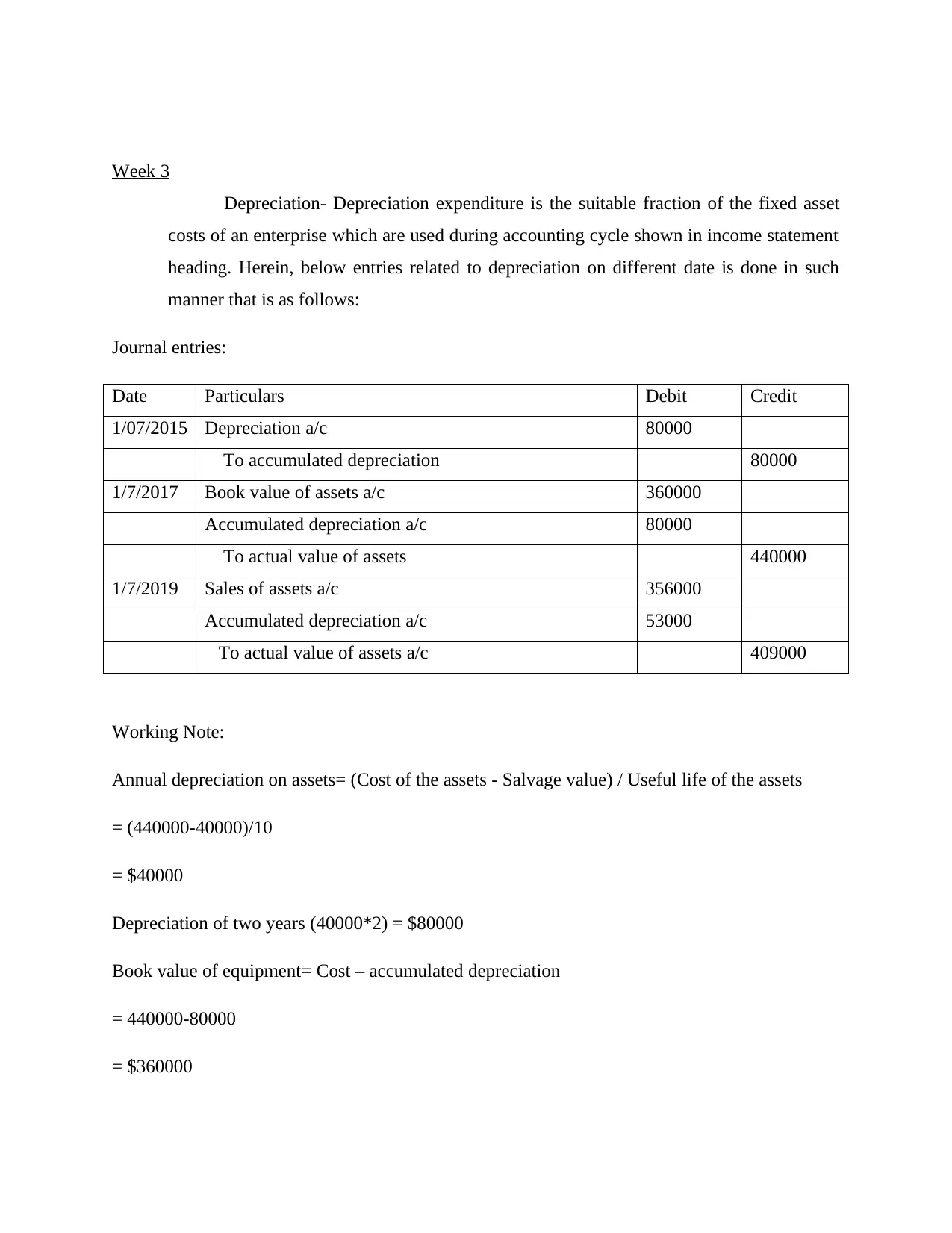
Week 3
Depreciation- Depreciation expenditure is the suitable fraction of the fixed asset
costs of an enterprise which are used during accounting cycle shown in income statement
heading. Herein, below entries related to depreciation on different date is done in such
manner that is as follows:
Journal entries:
Date Particulars Debit Credit
1/07/2015 Depreciation a/c 80000
To accumulated depreciation 80000
1/7/2017 Book value of assets a/c 360000
Accumulated depreciation a/c 80000
To actual value of assets 440000
1/7/2019 Sales of assets a/c 356000
Accumulated depreciation a/c 53000
To actual value of assets a/c 409000
Working Note:
Annual depreciation on assets= (Cost of the assets - Salvage value) / Useful life of the assets
= (440000-40000)/10
= $40000
Depreciation of two years (40000*2) = $80000
Book value of equipment= Cost – accumulated depreciation
= 440000-80000
= $360000
Depreciation- Depreciation expenditure is the suitable fraction of the fixed asset
costs of an enterprise which are used during accounting cycle shown in income statement
heading. Herein, below entries related to depreciation on different date is done in such
manner that is as follows:
Journal entries:
Date Particulars Debit Credit
1/07/2015 Depreciation a/c 80000
To accumulated depreciation 80000
1/7/2017 Book value of assets a/c 360000
Accumulated depreciation a/c 80000
To actual value of assets 440000
1/7/2019 Sales of assets a/c 356000
Accumulated depreciation a/c 53000
To actual value of assets a/c 409000
Working Note:
Annual depreciation on assets= (Cost of the assets - Salvage value) / Useful life of the assets
= (440000-40000)/10
= $40000
Depreciation of two years (40000*2) = $80000
Book value of equipment= Cost – accumulated depreciation
= 440000-80000
= $360000
⊘ This is a preview!⊘
Do you want full access?
Subscribe today to unlock all pages.

Trusted by 1+ million students worldwide
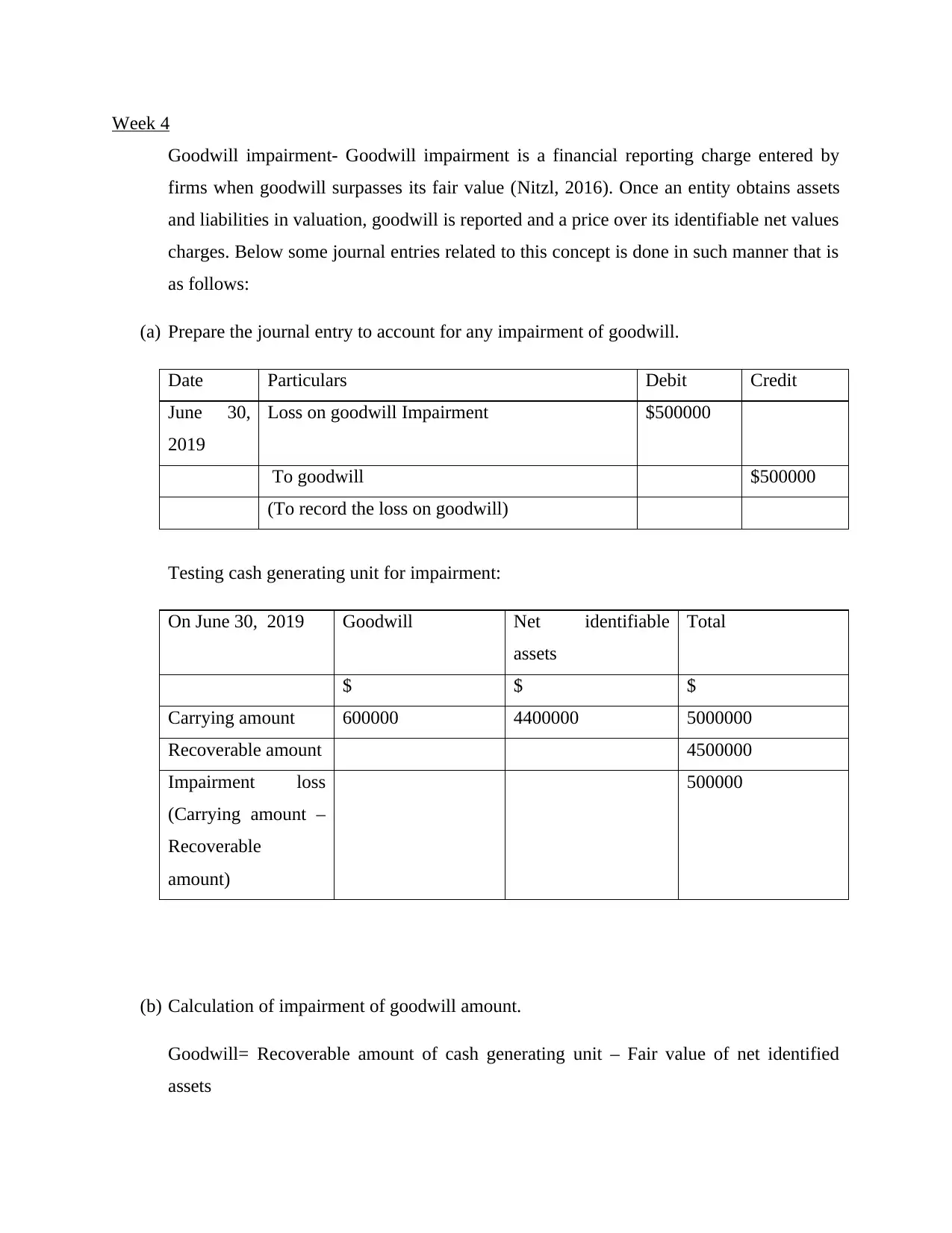
Week 4
Goodwill impairment- Goodwill impairment is a financial reporting charge entered by
firms when goodwill surpasses its fair value (Nitzl, 2016). Once an entity obtains assets
and liabilities in valuation, goodwill is reported and a price over its identifiable net values
charges. Below some journal entries related to this concept is done in such manner that is
as follows:
(a) Prepare the journal entry to account for any impairment of goodwill.
Date Particulars Debit Credit
June 30,
2019
Loss on goodwill Impairment $500000
To goodwill $500000
(To record the loss on goodwill)
Testing cash generating unit for impairment:
On June 30, 2019 Goodwill Net identifiable
assets
Total
$ $ $
Carrying amount 600000 4400000 5000000
Recoverable amount 4500000
Impairment loss
(Carrying amount –
Recoverable
amount)
500000
(b) Calculation of impairment of goodwill amount.
Goodwill= Recoverable amount of cash generating unit – Fair value of net identified
assets
Goodwill impairment- Goodwill impairment is a financial reporting charge entered by
firms when goodwill surpasses its fair value (Nitzl, 2016). Once an entity obtains assets
and liabilities in valuation, goodwill is reported and a price over its identifiable net values
charges. Below some journal entries related to this concept is done in such manner that is
as follows:
(a) Prepare the journal entry to account for any impairment of goodwill.
Date Particulars Debit Credit
June 30,
2019
Loss on goodwill Impairment $500000
To goodwill $500000
(To record the loss on goodwill)
Testing cash generating unit for impairment:
On June 30, 2019 Goodwill Net identifiable
assets
Total
$ $ $
Carrying amount 600000 4400000 5000000
Recoverable amount 4500000
Impairment loss
(Carrying amount –
Recoverable
amount)
500000
(b) Calculation of impairment of goodwill amount.
Goodwill= Recoverable amount of cash generating unit – Fair value of net identified
assets
Paraphrase This Document
Need a fresh take? Get an instant paraphrase of this document with our AI Paraphraser
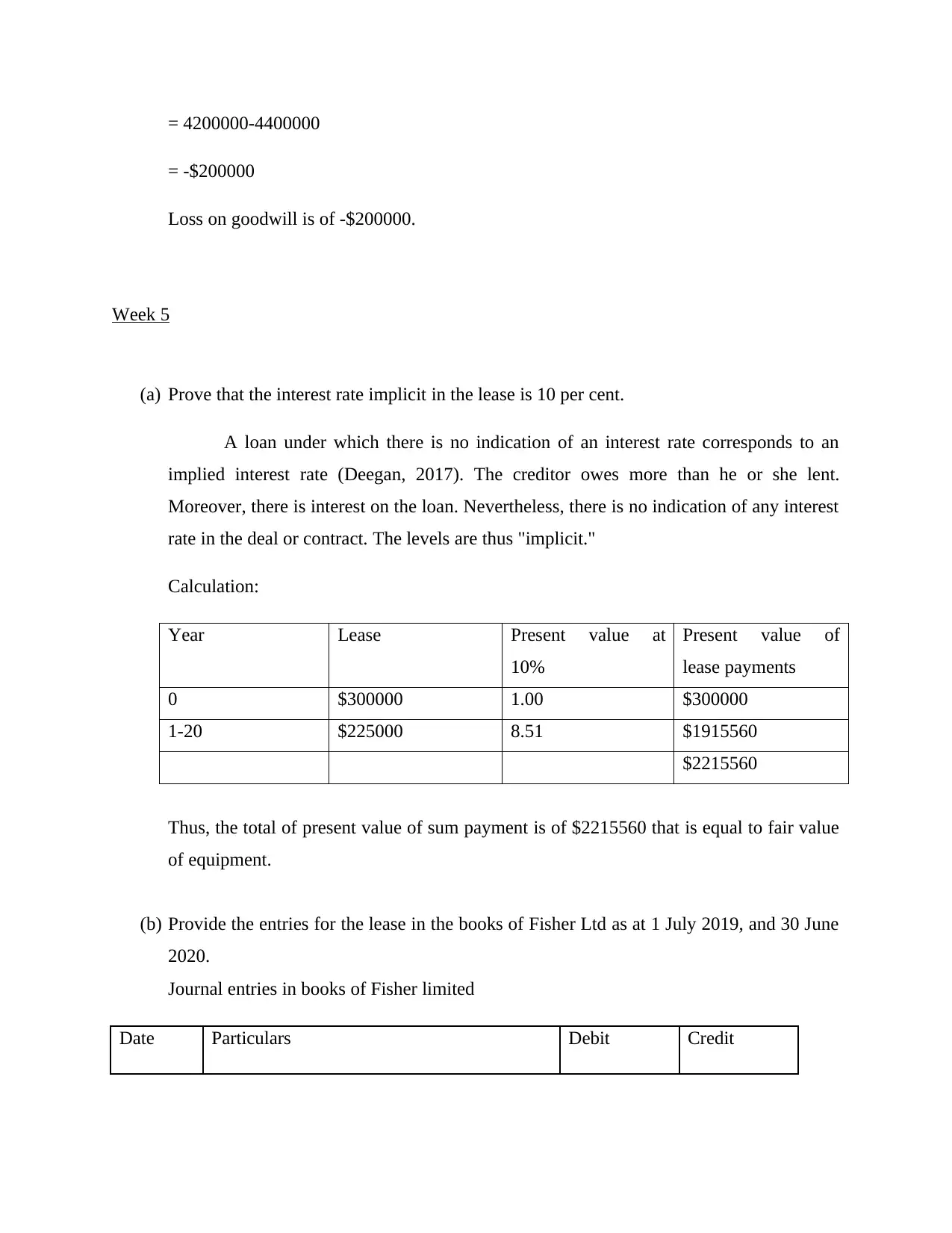
= 4200000-4400000
= -$200000
Loss on goodwill is of -$200000.
Week 5
(a) Prove that the interest rate implicit in the lease is 10 per cent.
A loan under which there is no indication of an interest rate corresponds to an
implied interest rate (Deegan, 2017). The creditor owes more than he or she lent.
Moreover, there is interest on the loan. Nevertheless, there is no indication of any interest
rate in the deal or contract. The levels are thus "implicit."
Calculation:
Year Lease Present value at
10%
Present value of
lease payments
0 $300000 1.00 $300000
1-20 $225000 8.51 $1915560
$2215560
Thus, the total of present value of sum payment is of $2215560 that is equal to fair value
of equipment.
(b) Provide the entries for the lease in the books of Fisher Ltd as at 1 July 2019, and 30 June
2020.
Journal entries in books of Fisher limited
Date Particulars Debit Credit
= -$200000
Loss on goodwill is of -$200000.
Week 5
(a) Prove that the interest rate implicit in the lease is 10 per cent.
A loan under which there is no indication of an interest rate corresponds to an
implied interest rate (Deegan, 2017). The creditor owes more than he or she lent.
Moreover, there is interest on the loan. Nevertheless, there is no indication of any interest
rate in the deal or contract. The levels are thus "implicit."
Calculation:
Year Lease Present value at
10%
Present value of
lease payments
0 $300000 1.00 $300000
1-20 $225000 8.51 $1915560
$2215560
Thus, the total of present value of sum payment is of $2215560 that is equal to fair value
of equipment.
(b) Provide the entries for the lease in the books of Fisher Ltd as at 1 July 2019, and 30 June
2020.
Journal entries in books of Fisher limited
Date Particulars Debit Credit
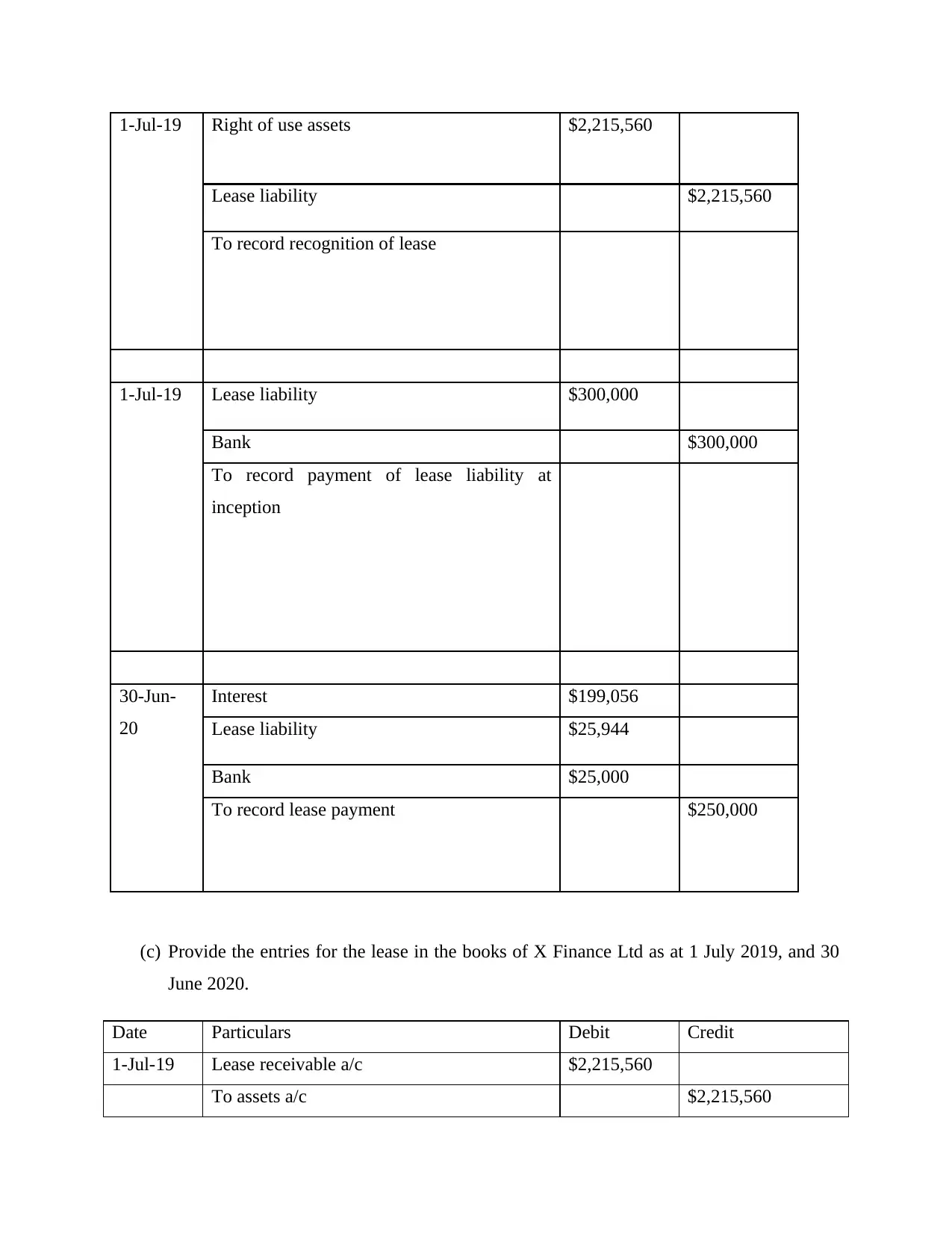
1-Jul-19 Right of use assets $2,215,560
Lease liability $2,215,560
To record recognition of lease
1-Jul-19 Lease liability $300,000
Bank $300,000
To record payment of lease liability at
inception
30-Jun-
20
Interest $199,056
Lease liability $25,944
Bank $25,000
To record lease payment $250,000
(c) Provide the entries for the lease in the books of X Finance Ltd as at 1 July 2019, and 30
June 2020.
Date Particulars Debit Credit
1-Jul-19 Lease receivable a/c $2,215,560
To assets a/c $2,215,560
Lease liability $2,215,560
To record recognition of lease
1-Jul-19 Lease liability $300,000
Bank $300,000
To record payment of lease liability at
inception
30-Jun-
20
Interest $199,056
Lease liability $25,944
Bank $25,000
To record lease payment $250,000
(c) Provide the entries for the lease in the books of X Finance Ltd as at 1 July 2019, and 30
June 2020.
Date Particulars Debit Credit
1-Jul-19 Lease receivable a/c $2,215,560
To assets a/c $2,215,560
⊘ This is a preview!⊘
Do you want full access?
Subscribe today to unlock all pages.

Trusted by 1+ million students worldwide
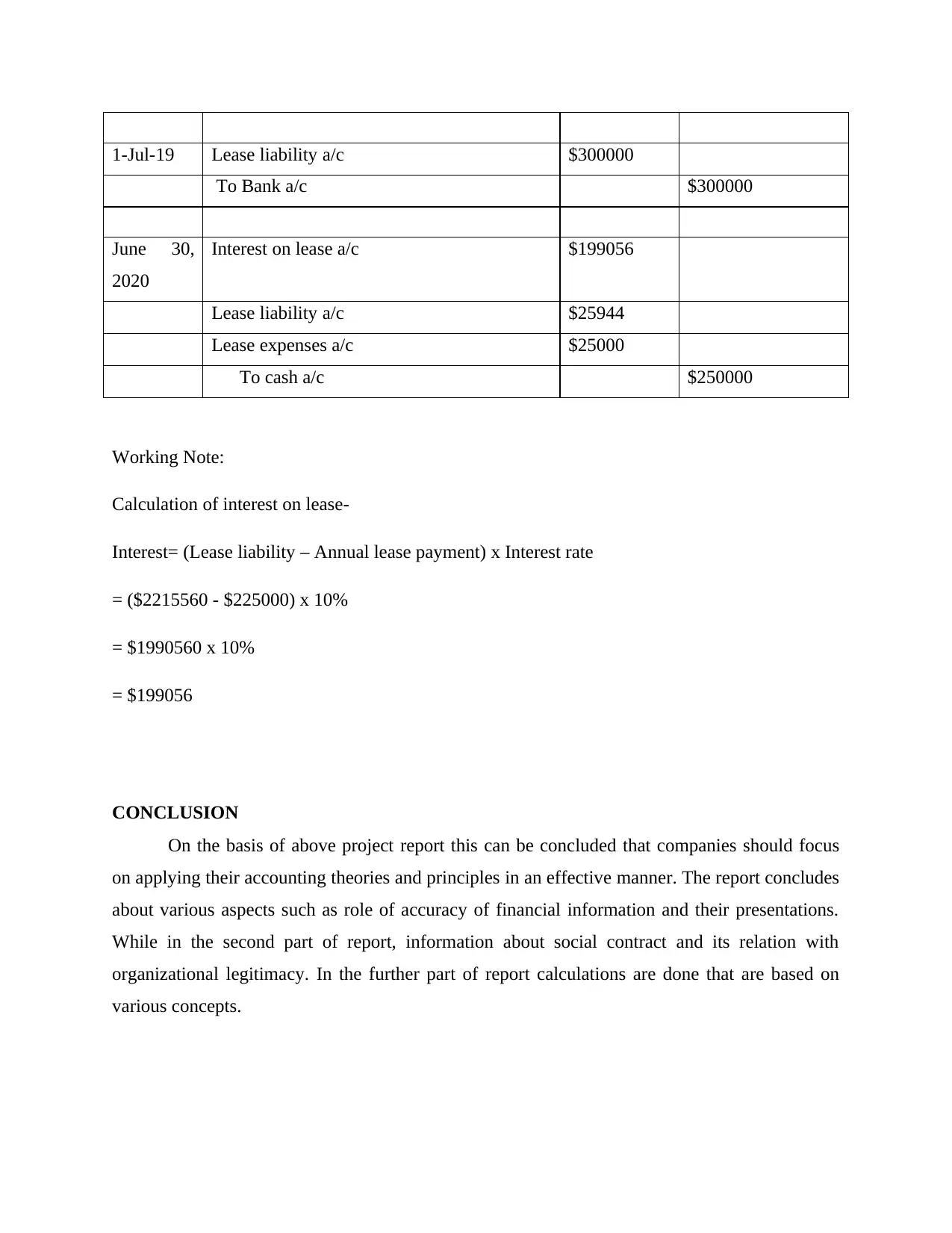
1-Jul-19 Lease liability a/c $300000
To Bank a/c $300000
June 30,
2020
Interest on lease a/c $199056
Lease liability a/c $25944
Lease expenses a/c $25000
To cash a/c $250000
Working Note:
Calculation of interest on lease-
Interest= (Lease liability – Annual lease payment) x Interest rate
= ($2215560 - $225000) x 10%
= $1990560 x 10%
= $199056
CONCLUSION
On the basis of above project report this can be concluded that companies should focus
on applying their accounting theories and principles in an effective manner. The report concludes
about various aspects such as role of accuracy of financial information and their presentations.
While in the second part of report, information about social contract and its relation with
organizational legitimacy. In the further part of report calculations are done that are based on
various concepts.
To Bank a/c $300000
June 30,
2020
Interest on lease a/c $199056
Lease liability a/c $25944
Lease expenses a/c $25000
To cash a/c $250000
Working Note:
Calculation of interest on lease-
Interest= (Lease liability – Annual lease payment) x Interest rate
= ($2215560 - $225000) x 10%
= $1990560 x 10%
= $199056
CONCLUSION
On the basis of above project report this can be concluded that companies should focus
on applying their accounting theories and principles in an effective manner. The report concludes
about various aspects such as role of accuracy of financial information and their presentations.
While in the second part of report, information about social contract and its relation with
organizational legitimacy. In the further part of report calculations are done that are based on
various concepts.
Paraphrase This Document
Need a fresh take? Get an instant paraphrase of this document with our AI Paraphraser
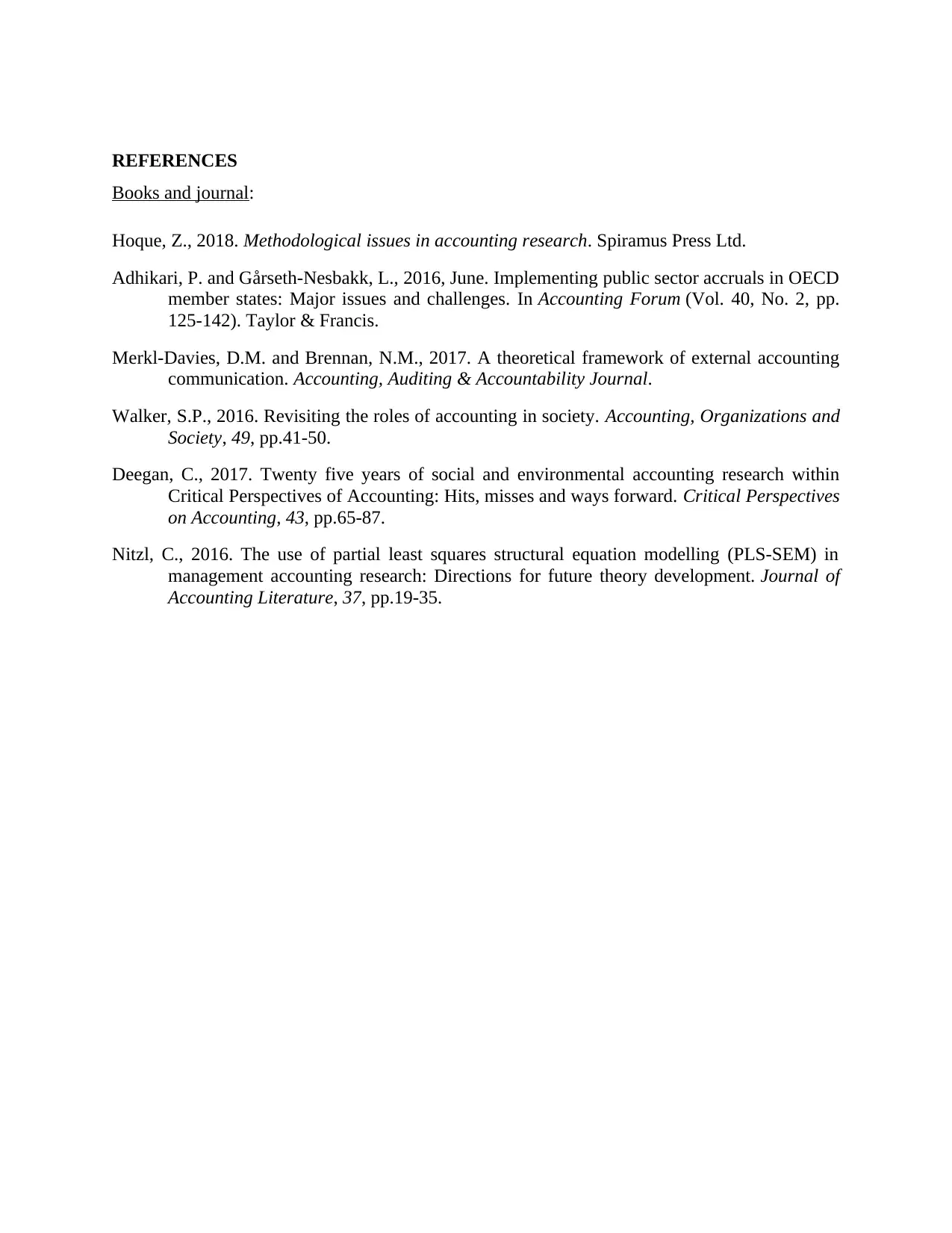
REFERENCES
Books and journal:
Hoque, Z., 2018. Methodological issues in accounting research. Spiramus Press Ltd.
Adhikari, P. and Gårseth-Nesbakk, L., 2016, June. Implementing public sector accruals in OECD
member states: Major issues and challenges. In Accounting Forum (Vol. 40, No. 2, pp.
125-142). Taylor & Francis.
Merkl-Davies, D.M. and Brennan, N.M., 2017. A theoretical framework of external accounting
communication. Accounting, Auditing & Accountability Journal.
Walker, S.P., 2016. Revisiting the roles of accounting in society. Accounting, Organizations and
Society, 49, pp.41-50.
Deegan, C., 2017. Twenty five years of social and environmental accounting research within
Critical Perspectives of Accounting: Hits, misses and ways forward. Critical Perspectives
on Accounting, 43, pp.65-87.
Nitzl, C., 2016. The use of partial least squares structural equation modelling (PLS-SEM) in
management accounting research: Directions for future theory development. Journal of
Accounting Literature, 37, pp.19-35.
Books and journal:
Hoque, Z., 2018. Methodological issues in accounting research. Spiramus Press Ltd.
Adhikari, P. and Gårseth-Nesbakk, L., 2016, June. Implementing public sector accruals in OECD
member states: Major issues and challenges. In Accounting Forum (Vol. 40, No. 2, pp.
125-142). Taylor & Francis.
Merkl-Davies, D.M. and Brennan, N.M., 2017. A theoretical framework of external accounting
communication. Accounting, Auditing & Accountability Journal.
Walker, S.P., 2016. Revisiting the roles of accounting in society. Accounting, Organizations and
Society, 49, pp.41-50.
Deegan, C., 2017. Twenty five years of social and environmental accounting research within
Critical Perspectives of Accounting: Hits, misses and ways forward. Critical Perspectives
on Accounting, 43, pp.65-87.
Nitzl, C., 2016. The use of partial least squares structural equation modelling (PLS-SEM) in
management accounting research: Directions for future theory development. Journal of
Accounting Literature, 37, pp.19-35.
1 out of 11
Related Documents
Your All-in-One AI-Powered Toolkit for Academic Success.
+13062052269
info@desklib.com
Available 24*7 on WhatsApp / Email
![[object Object]](/_next/static/media/star-bottom.7253800d.svg)
Unlock your academic potential
Copyright © 2020–2025 A2Z Services. All Rights Reserved. Developed and managed by ZUCOL.





